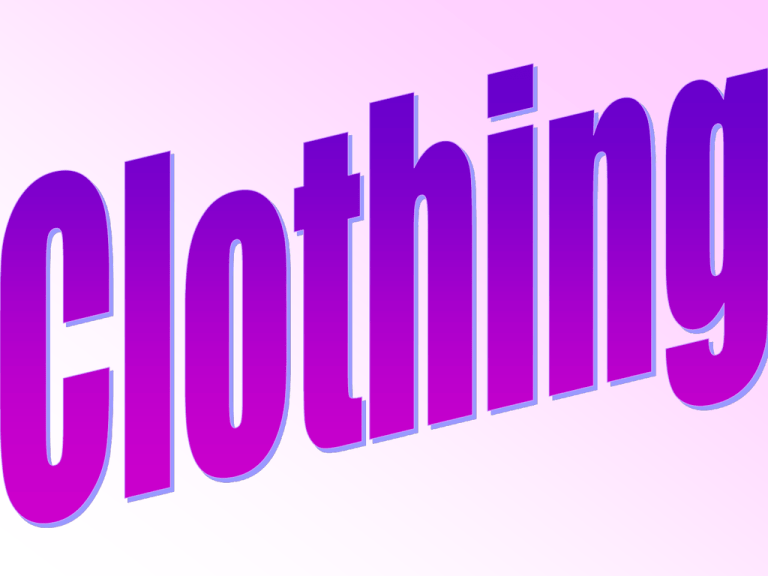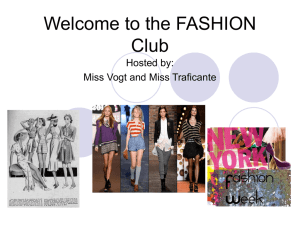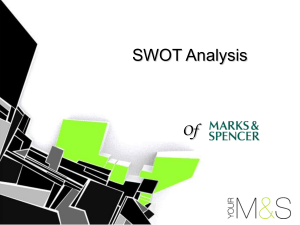Clothing
advertisement

Your overall image is made up of 3 V’s: • Verbal Message (what you say): 7% of image • Vocal Message (how you say it): 38% of image • Visual Message (how you look, ex. clothes, grooming) 55% of image • 80% of a client’s decision to do business with you is due to IMAGE Fashion • “the prevailing style at a given time” • Fashion includes: – – – – cars (popular cars at the time) furniture styles where we take vacations language (popular sayings) Fashion Characteristics • Fashion is constantly changing • Fashion cannot exist in isolation; requires an audience • Fashion is followed; people adopt fashion for a while and then abandon it • Fad-fashion accepted for a short period of time • Classic-fashion accepted for a long period of time • Follows a cycle - merchandise acceptance curve Merchandise Acceptance Curve Introduction of fashion General Acceptance of fashion Decline of fashion Example of the fashion cycle of a Fad, Fashion, and Classic Classic Fashion Fad Who Dictates Fashion? • Clothing designers-have the ideas each year • Manufacturers-choose to produce only those products they think will sell • Retailers-select products based on market research and previous sales records • CONSUMERS-make the ultimate decision about what or whether to buy the product Kinds of Clothing Stores • Department store-wide selection; price range is medium to high; variety of products, styles, colors, etc.; offer services; ex. Marshall Fields, Nordstroms • Specialty store-sells only one type of clothing or clothes for particular group; price range is medium to high; clothing categories narrower but selection of specialty clothing large; ex. Gap, Paul Harris Kinds of Clothing Stores cont. • Mass Merchandise store-have many stores; sell to large numbers of people; similar to department stores but prices tend to be in the medium range; carry fewer brand names; ex. Sears, JC Penney • Discount store-appeal to the customer on the basis of price; carries a wide range of goods; ex. Target, K-Mart, Wal-Mart Kinds of Clothing Stores cont. • Off-Price store-name brand merchandise at lower prices; obtain their merchandise from manufacturer’s canceled orders, overruns, and season end close-outs; ex. Marhsall’s, Loehmann’s, T.J. Maxx • Factory Outlet store-owned and operated by clothing manufacturers; offer name brand merchandise at low prices; ex. Bass She Outlet, Burlington Coat Factory Kinds of Clothing Stores cont. • Second Hand stores-used clothing; able to find exception values; selection limited in terms of color, size, styles, etc.; ex. Goodwill, Salvation Army. • 2 Types of Second hand stores – thrift-people donate merchandise and prices very inexpensive – consignment-people bring in merchandise and receive a portion of the selling cost. Merchandise more expensive but overall the clothing is better quality. Clothing Quality Indicators • • • • • • • • Design of garment Quality of fabric Quality of construction Overall appearance Fit Comfort Acceptable for intended use Price Quality Indicators Cont. • • • • • • • • Fiber content Care instructions Seams matched Seams pressed Seams finished and even Hem even Waistband straight Zipper even and securely sewn Quality Indicators Cont. • • • • • • • • • Fasteners secure Pockets secure Collars interfaced Collar points even Top stitching even and not stopped and started Buttons secure Buttonholes well sewn No tucks or wrinkles in sleeves No rips or long threads Cost of Clothing • To determine the cost of clothing: Formula Total cost of garment divided by the # of times worn (estimate the # of times clothing will be worn) • Have knowledge of price & quality in different clothing types • Cross Shop-shop several different stores before buying • Read hang tags & labels • Know your fabrics • Watch for workmanship/quality • Build wardrobe around a few coordinated pieces • Purchase basic items in multiple units, such as socks • Keep records of brand performance and buy brands that you like • Retain all labels and sales slips • Don’t buy fad items as they will not be in fashion long • Avoid bargains you don’t need • Don’t shop when your desperate • Look for economical clothing choices • Watch for hidden costs, such as dry cleaning or storage costs





